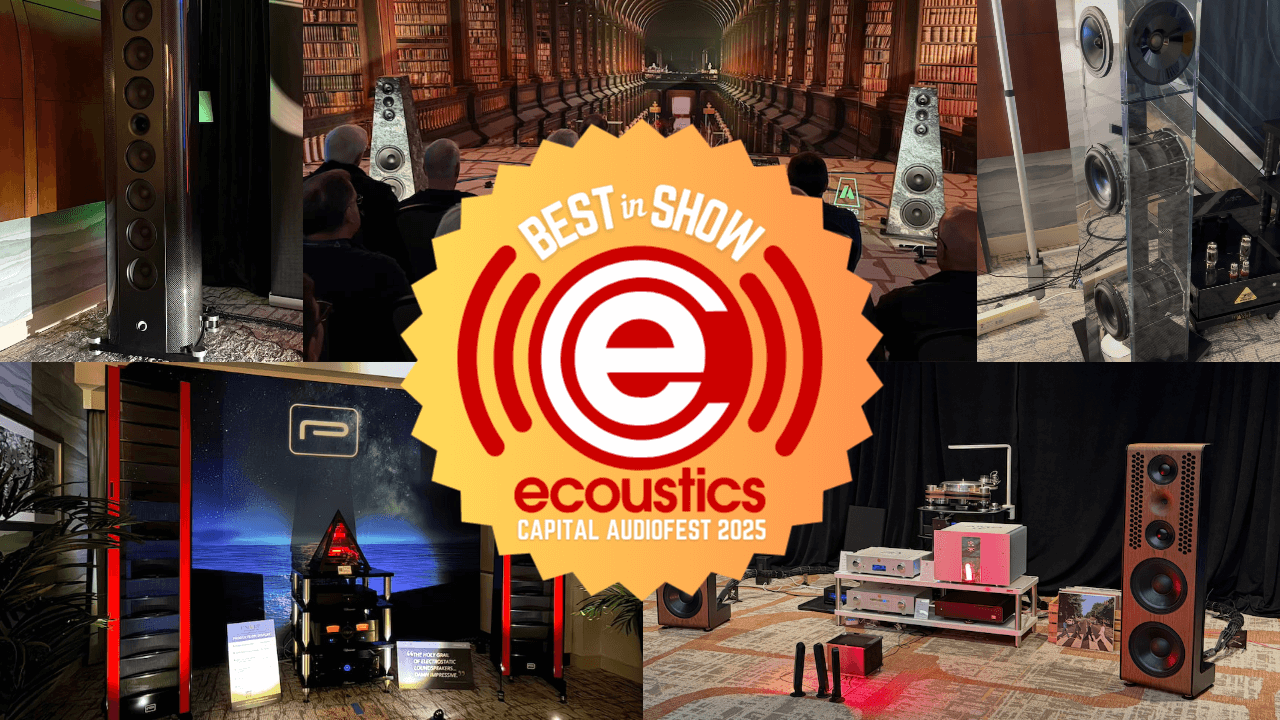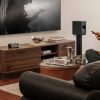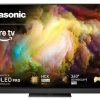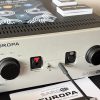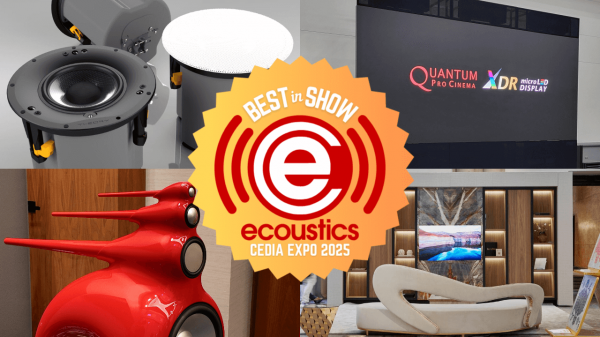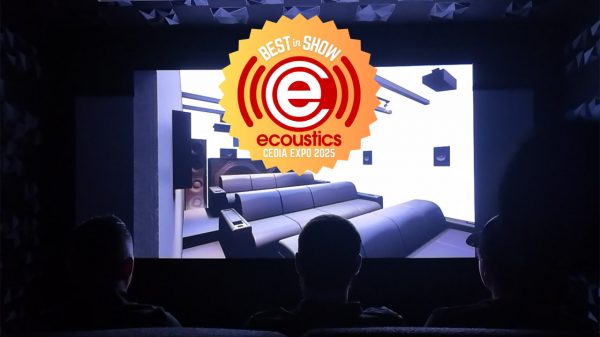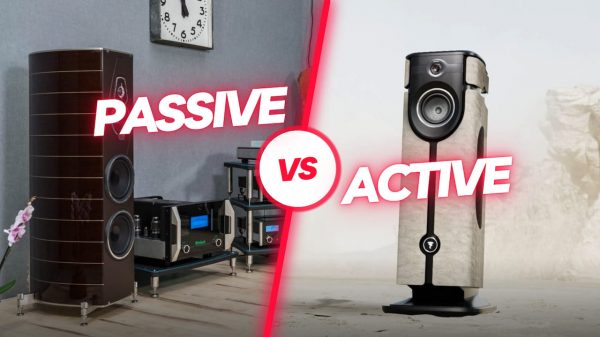Capital Audiofest 2025 closed out the global hi-fi show calendar at the Hilton Rockville in Maryland from November 14–16, wrapping up a very busy two months that also saw events in Warsaw, Paris, Dallas, New Jersey, Singapore, and Toronto. Spread across five hotel floors and two spillover ballrooms at the Even Hotel across the street, this year’s CAF packed 122 demo rooms with everything from handcrafted levitating turntables to six-figure loudspeaker systems—most of them aimed squarely at the one percent of the audiophile world.
As always, no single person could cover it all, but we came across plenty of standout gear—exceptional sound that proved true high-end audio still has the power to inspire, even if most of it is priced for those with titanium Amex cards.
Still, the weekend raised a few uncomfortable questions: have we hit the saturation point for global audio shows? Are the big hotel events losing relevance to smaller regional gatherings? The crowd at CAF skewed significantly older—easily 25 to 30 years older than those at Warsaw or CanJam Dallas—suggesting that while passion for great sound endures, the audience itself might be graying faster than the industry wants to admit at these types of shows.
Table of contents
- Altec Is Back: The Legendary American Audio Brand Returns in 2025
- Dr. Edgar Choueiri and the Mind-Bending Bacch DrC² Experience
- Popori WR2 Electrostatic Speakers: When Precision Meets Psychoacoustics
- Silent Pound: Lithuanian Engineering That Stole the Show
- Focal Diva Mezza Utopia: The Future of All-in-One Luxury Audio
- Perfect8 Cube T & Triangle Art: Transparency Done Right
- ATC SCM20ASL: Studio Precision for the Living Room
- Totem Thunderbird & Chord Electronics: Small Footprint, Big Sound
- Grandinote: Big, Bold, and Built for Volume
- Acora Reference: Granite Monuments to Sonic Perfection
- Chesky LC2: Next-Gen Innovation from a Rising Star
- Mission 700 & 750: Classic Sound, Modern Execution
- GoldenEar T44: A Serious Sleeper in the $5K Class
- Perlisten S7t: Effortless Realism at a High Price
- Alcons Audio Home Theater: When Price Is No Object
- Krix Home Theater: Small Room, Big Impact
- Paradigm / Anthem 7.2.4 Home Theater: Smart Design, Big Payoff
- SVS / Orchard Audio 5.2.4 Home Theater: Class D for the Win
- STAX SR-007S Combo: Electrostatic Excellence
- Technics / VPE 2.1 System: Small Setup, Big Surprise
- Best Accessory: IsoAcoustics GAIA Neo
- The Bottom Line
Altec Is Back: The Legendary American Audio Brand Returns in 2025

That’s right—Altec Lansing, the company that practically invented the hi-fi industry, is back in the high-end audio game. The brand made a bold statement at CAF 2025 with a pair of $89,000 planar magnetic loudspeakers, each accompanied by its own subwoofer system. Standing nearly seven feet tall and reaching perilously close to the ceiling, the panels looked far too large for a typical hotel room—yet somehow, they worked.
The secret lies in their unique front-and-back radiation pattern, which is designed to cancel early sidewall reflections that usually smear stereo imaging in smaller spaces. The result was an unexpectedly clean and open soundstage, even in a less-than-ideal environment. While it’s unclear whether this exact model will ever reach full production, Altec Lansing hinted that smaller and more affordable versions based on the same acoustic principles are already in development.
In addition, word around the show floor was that Altec Lansing is developing revamped vintage models in time for the company’s 100th anniversary in 2027. No confirmation yet on a reborn Voice of the Theater with new horns—but if that actually happens, a sizable segment of the audiophile kingdom might just have an aneurysm on the spot.
Altec’s room also featured the new Valerion VisionMaster Max lifestyle projector ($5,000), which looked spectacular despite being placed off to the side at roughly a 45-degree angle. Hardly an ideal setup, but it may have needed the extra distance to achieve the massive screen size—or maybe there was simply nowhere else to put it. Either way, well done, Valerion—the image quality was outstanding, and it made those 4K Blu-ray concert demos that much more immersive.
Dr. Edgar Choueiri and the Mind-Bending Bacch DrC² Experience
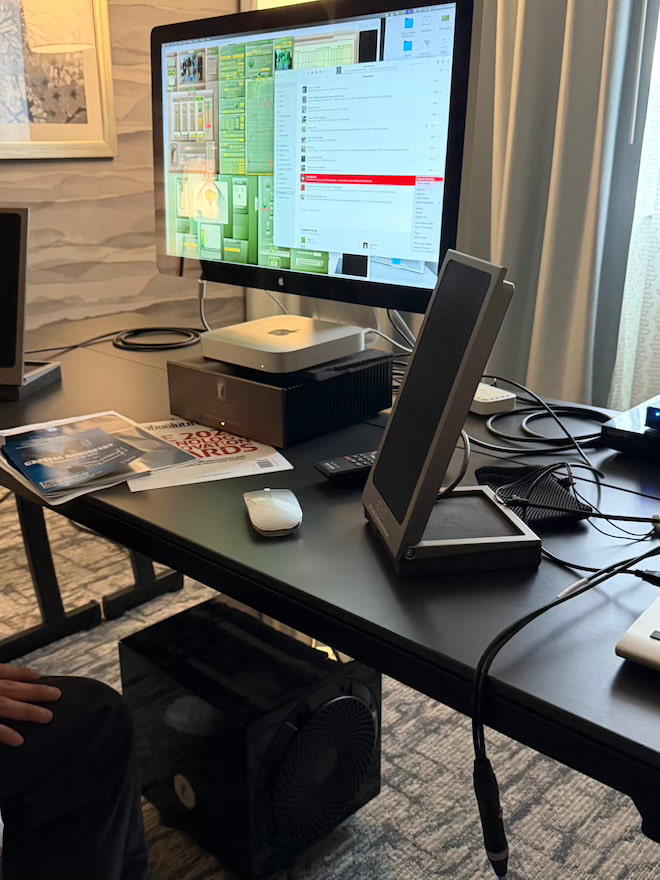
Nothing at Capital Audiofest 2025 impressed me more than Dr. Edgar Choueiri’s mind-bending demo inside The 3D3A Lab room—a setup that looked more like a modest desktop rig than a glimpse into the future of spatial audio. The system, dubbed Bacch DrC² (squared), consisted of a simple 2.1 planar magnetic speaker setup that shouldn’t have been capable of surrounding you with sound—and yet, it did exactly that.
The speakers themselves were custom planar magnetic panels, developed in collaboration with Audeze’s co-founder and CTO, Dr. Dragoslav Colich (aka “Dr. C”). Lightning-fast and ultra-responsive, they may very well be the world’s fastest transducers. On their own, they sounded exceptional. But the real magic came from Choueiri’s proprietary Bacch3D and Bacch-Stratos digital psychoacoustic processing. These algorithms transform any stereo track into a three-dimensional sound field that challenges your understanding of what two speakers can do.
The Bacch-Stratos technology goes even further—it can decode Dolby Atmos spatial cues to recreate a full 12.1-channel soundstage from just two front speakers. And yes, it works. This isn’t marketing fluff—it’s genuine, brain-twisting audio science in action. Here’s a short video of the demo on Instagram.
There is, however, one catch: the effect only works from a single, calibrated listening position. During setup, tiny microphones are placed in your ears while the Bacch software measures your exact head-related transfer functions, tailoring playback to your ears and seating distance. The result? Audio that doesn’t just sound immersive—it can actually whisper in your ear. Nothing else at CAF 2025 came close.
Popori WR2 Electrostatic Speakers: When Precision Meets Psychoacoustics
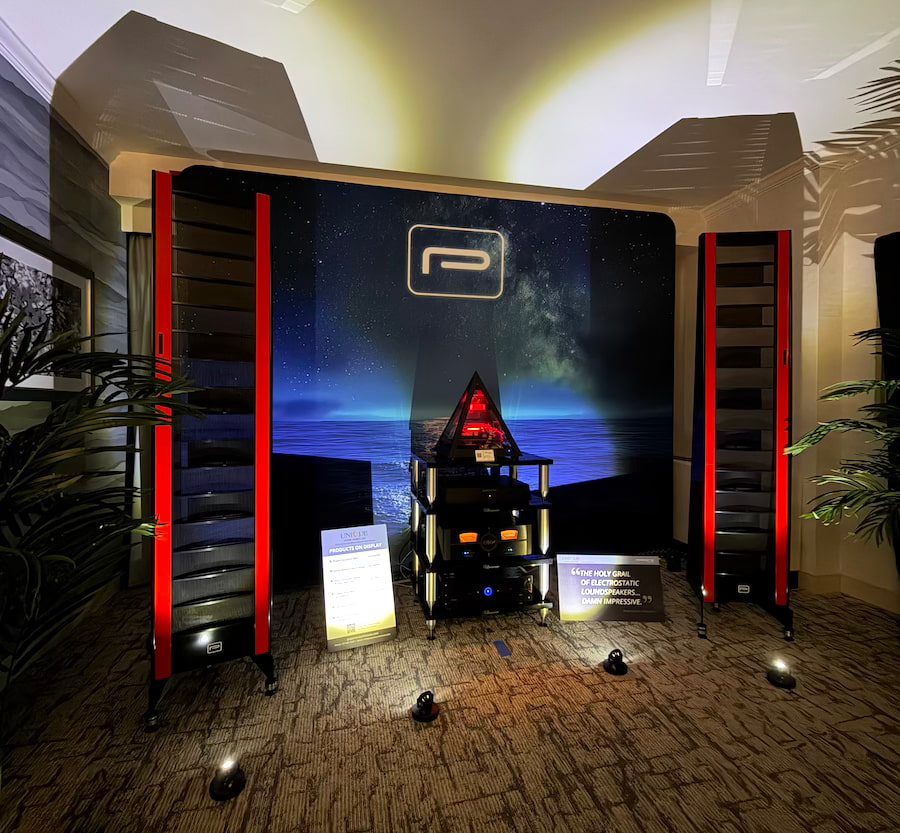
Despite the jaw-dropping capabilities of Bacch3D, only one exhibitor at Capital Audiofest 2025 actually put it to use—Popori Acoustics out of Hungary. They paired their WR2 Electrostatic Panels ($38,000/pair) with the Bacch3D processing system ($20,000), creating one of the most refined and spatially convincing demos at the show.
At first glance, the WR2 looks almost identical to Popori’s WR3 panels ($18,000), except for being roughly 9-inches (225 mm) taller. Sonically, the difference isn’t night and day, which raises a fair question about the near doubling in price for what amounts to incremental gains. That said, the WR2’s added surface area extends the low-end reach to around 30Hz, giving these otherwise ethereal panels a surprising sense of weight and authority.
Layer in Bacch3D, and the soundstage expands into a massive, holographic wall of sound. Instruments are rendered with pinpoint precision and lifelike scale, while the WR2’s electrostatic speed and microdynamics make every transient feel instantaneous. Whether or not the price jump is justified, there’s no denying that the WR2 + Bacch3D combo delivered one of the most convincing illusions of live performance at CAF 2025.
Silent Pound: Lithuanian Engineering That Stole the Show
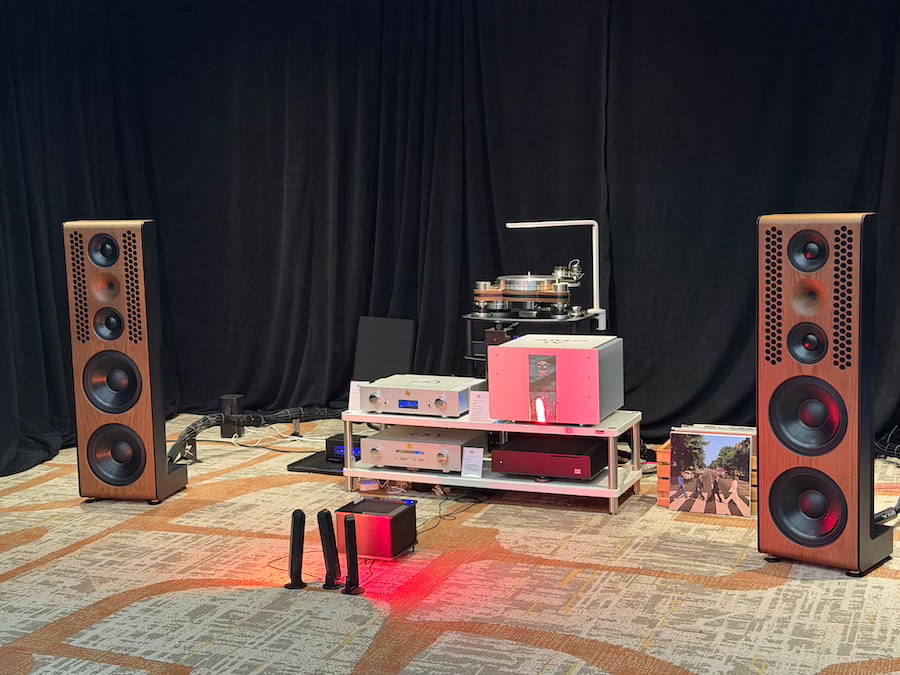
Staying on the Eastern European theme, Silent Pound from Lithuania delivered one of the most captivating demos of Capital Audiofest 2025. Their unique open-baffle Challenger II loudspeakers ($38,000/pair) were showcased in a room curated by House of Stereo, paired with over $100,000 worth of AVM electronics and a staggering $50,000 in Synergistic Research cabling. Overkill? Probably. But when the music started, none of that mattered—these speakers were simply breathtaking.
I queued up “Liberty” by Anette Askvik on several systems throughout the show, but none matched the Silent Pound setup for tone, texture, or sheer emotional depth. Female vocals sounded hauntingly real, the saxophone solo cut through the air with intensity and warmth, and the piano notes carried a quiet, resonant authority that lingered long after they faded. In a show dominated by spectacle and excess, Silent Pound reminded everyone what this hobby is supposed to be about: connection, nuance, and truth in sound. More of this, please.
Focal Diva Mezza Utopia: The Future of All-in-One Luxury Audio
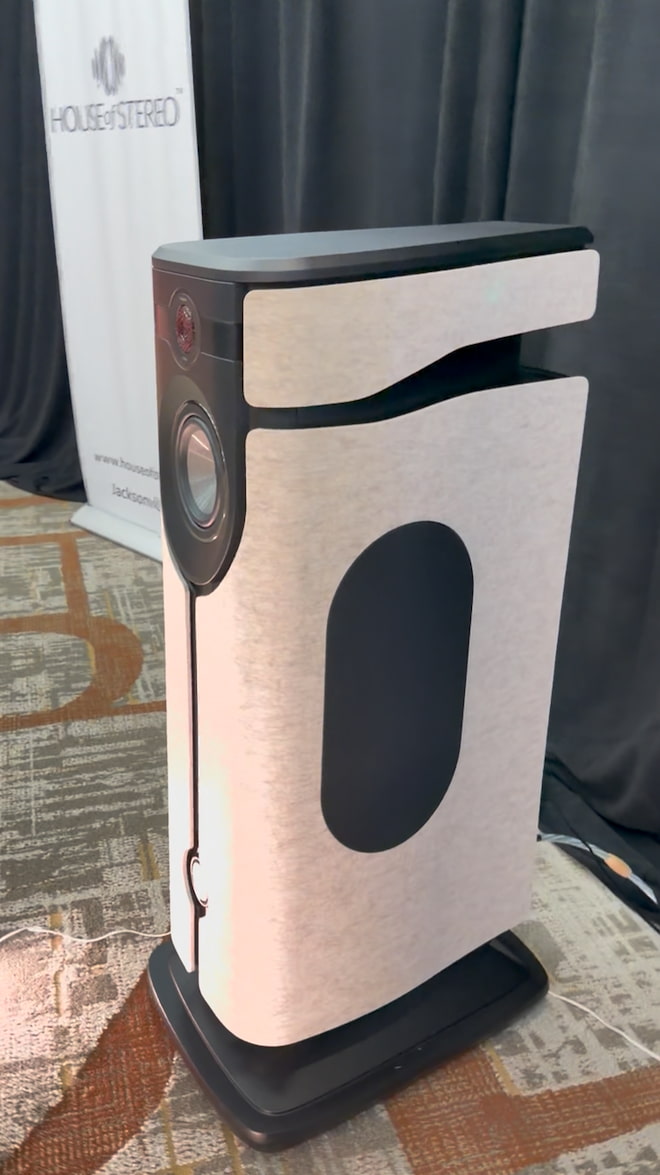
Also featured in the House of Stereo ballroom, the Focal Diva Mezza Utopia ($69K/pair) stood out not just for their looks, but for what they represent: a genuine high-end all-in-one wireless speaker system that doesn’t ask for a rack full of gear or a spiderweb of cables. Coming straight from the Focal/Naim ecosystem, these powered beauties only need a power cord and a Wi-Fi connection—plug them in, run through a brief calibration setup from their app, and you’re off.
Having just stepped out of the $200K Silent Pound system, expectations were sky-high—and surprisingly, the Divas held their own. Their sound was bold, refined, and unmistakably Focal/Naim in character: dynamic, detailed, and musically engaging. The calibration process tightens the imaging and bass response far better than most “smart” systems, proving that convenience and high-end sound don’t have to be mutually exclusive. Gorgeous to look at and thrilling to hear, the Diva Mezza Utopia shows that Focal can merge lifestyle design with true reference-level performance.
Perfect8 Cube T & Triangle Art: Transparency Done Right
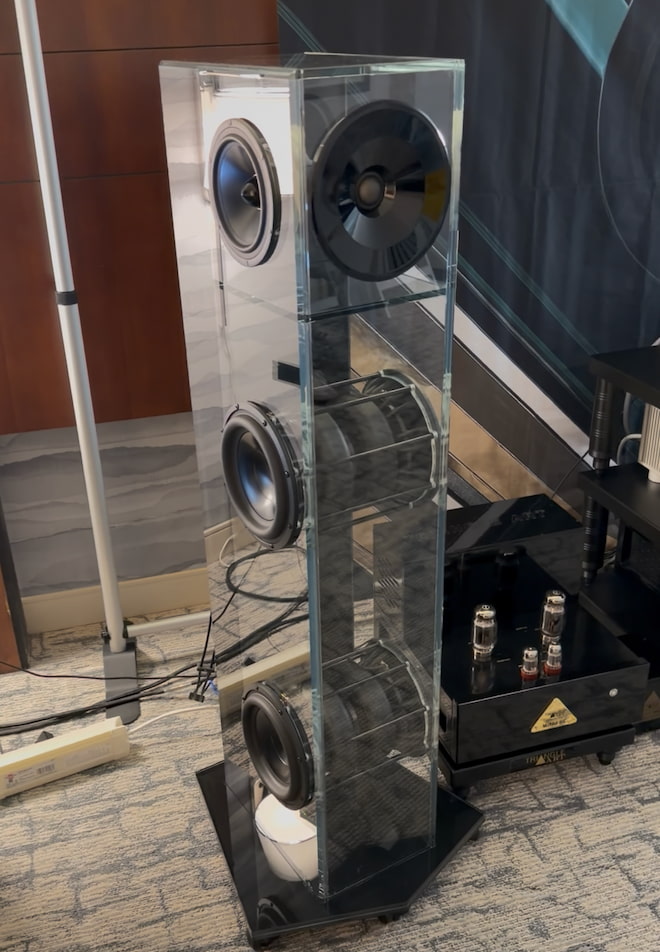
My first encounter with Perfect8 speakers was equal parts curiosity and surprise. Walking into the room with Triangle Art electronics and turntable, I was greeted by what looked like modern art pieces—glass-enclosed loudspeakers that seemed almost too delicate to produce serious sound. A few minutes later, Michael Fremer of Tracking Angle walked in with a test pressing, and the room fell silent as the music started. Without any expectations or context, I was struck by how natural and dimensional the piano tones sounded—clear, balanced, and full of life.

Although I initially thought I was listening through all Triangle Art gear, the turntable was actually connected to a Ypsilon Phaeton integrated amplifier (standard version) along with Triangle Art phono stage. It’s hard to say what contributed most to the result, but the Perfect8 Cube T ($62,500/pair) deserves real credit. The speaker’s design is unconventional: a glass cabinet with dual opposing side woofers that cancel cabinet resonances, and a top-mounted tweeter with a wide waveguide that offers an almost cardioid-like dispersion. The result isn’t showy or exaggerated—it’s simply open, uncolored, and deeply coherent. The Cube T may look fragile, but it’s one of the most thoughtfully engineered and musically balanced designs I heard at CAF 2025.
ATC SCM20ASL: Studio Precision for the Living Room
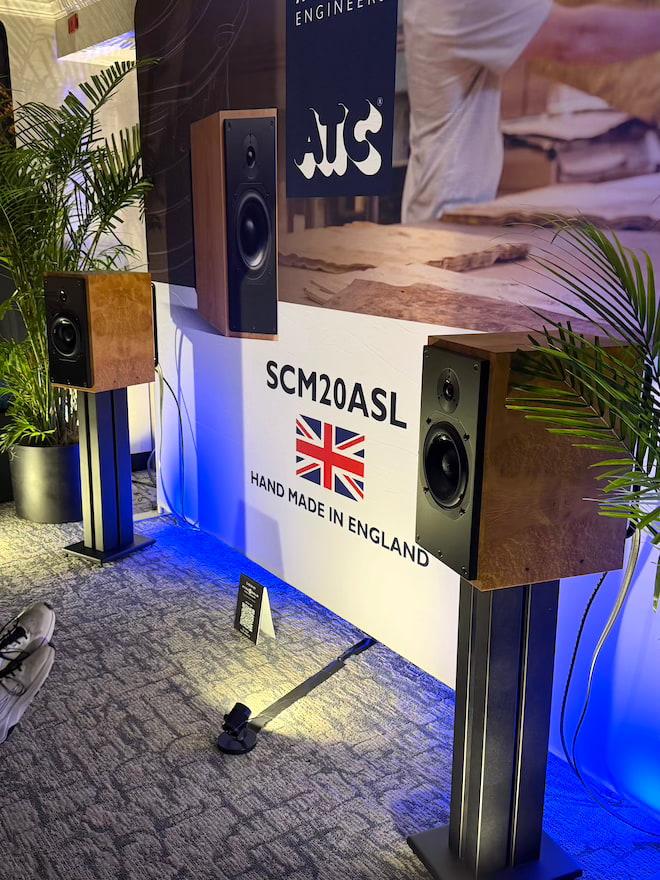
This was my third encounter with the ATC SCM20ASL Active Bookshelf Speakers ($11,999/pair as shown in Burr Magnolia finish) at a hi-fi show, and once again, they delivered exactly what ATC is known for—superb detail, pinpoint imaging, and a soundstage that feels far larger than the speakers themselves. Few active bookshelf designs at this price point offer such a seamless blend of transparency and authority.
Part of the secret is in the engineering: the built-in amplifiers are purpose-designed to extract maximum performance from the dedicated woofer and tweeter, eliminating the guesswork of amp matching. It’s a level of integration that pays real dividends in control, dynamics, and tonal balance. Paired here with an ATC CD player and Innuos streamer, the system sounded every bit like a compact mastering setup—and that’s no accident. ATC’s professional monitors are staples in top studios around the world, and the SCM20ASL brings that same studio-grade honesty into the home without compromise.
Totem Thunderbird & Chord Electronics: Small Footprint, Big Sound
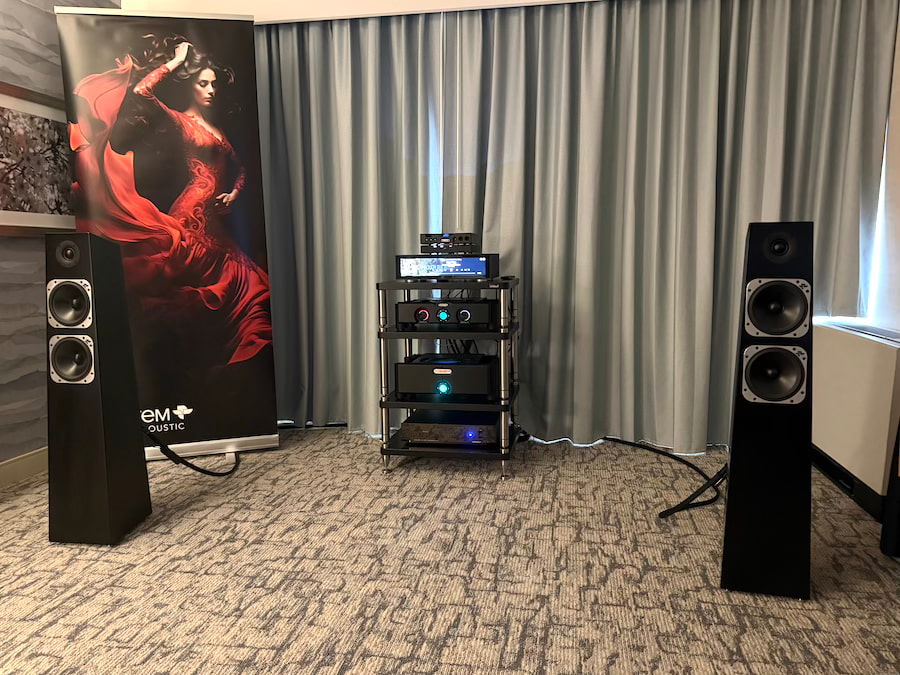
The Totem Acoustic and Chord Electronics room, hosted by Gramophone, turned out to be one of the most musically engaging setups at Capital Audiofest 2025. The brand-new Totem Thunderbird loudspeakers ($13,000/pair) were paired with a Chord integrated amplifier, Hugo TT2 DAC, and M-Scaler—a front-end totaling around $35,000. It was my first real listen to Totem, and the experience left a strong impression.
For a relatively compact floorstander, the Thunderbird delivers sound well beyond its size. Bass digs deep with control and texture, the soundstage extends far beyond the speaker boundaries, and the imaging remains stable even as you move around the room—a wide sweet spot that keeps every seat in play. Detail retrieval and tonal balance were excellent, but what really stood out was how easily the system pulled you into the performance. The Chord front end provided speed and precision, while the Totems added warmth and presence. Together, they made one of the most complete and inviting listening experiences of the show.
Click here for sound clips from the room on Instagram.
Grandinote: Big, Bold, and Built for Volume

When you see a massive loudspeaker loaded with drivers, you expect big sound—but not every giant delivers. The Grandinote Mach 8 Evoluzione loudspeakers ($128,000/pair) with Solo ($30,000) Class A Integrated absolutely did. Towering in both presence and performance, it combined explosive dynamics with a sense of scale that few rooms at CAF 2025 could match. Part of the secret involves a speaker encased in 15mm CNC milled aluminum with true premium carbon fiber side panels, which is said to eliminate all resonance without the use of sound-absorbing material. Amazingly, the Mach 8 Evoluzione is able to deliver 18Hz-20kHz frequency response while achieving 98db sensitivity without use of a crossover.
This is a speaker that comes alive at higher volumes, inviting you to lean on the throttle and feel the music hit with real physical force. Despite its 6′ 3″ (190cm) size, it maintained impressive composure and clarity, never sounding bloated or harsh. For those who love their listening sessions loud, immersive, and unapologetically visceral, Grandinote was one of the few systems that truly delivered on that promise.
Acora Reference: Granite Monuments to Sonic Perfection
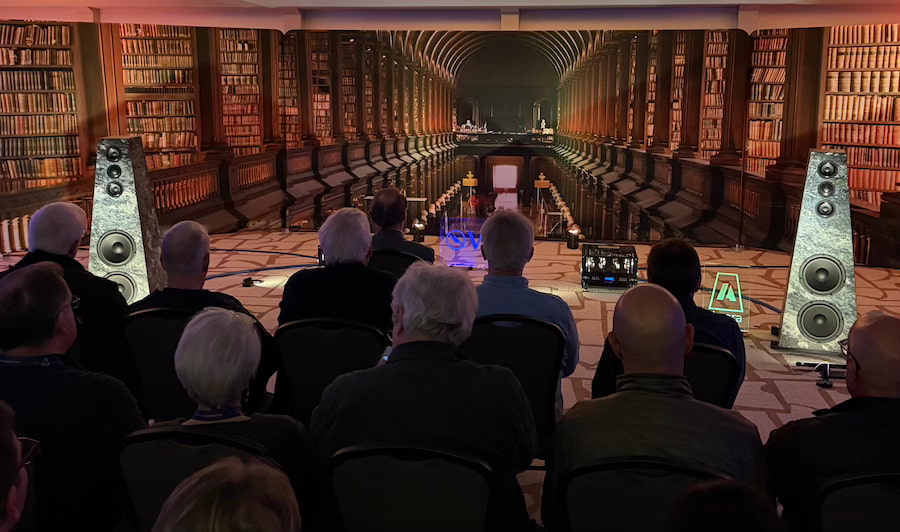
In the stratospheric price range where cost is no object, the Acora’s flagship VRC loudspeakers ($318,000/pair as shown) stand among the finest in the world. These floorstanding towers are equal parts speaker and sculpture, each one hewn from solid granite—an approach that all but eliminates cabinet resonance and gives the speakers a commanding physical presence.
Sonically, they’re just as formidable. The Acora VRC create an uncannily lifelike three-dimensional soundstage, with phantom imaging so precise that vocals and instruments appear suspended between—and even behind—the speakers. The presentation is expansive yet controlled, powerful yet natural. Simply put, these are dream-level loudspeakers—the kind you only audition when you have both the means and the room to let them breathe.
Chesky LC2: Next-Gen Innovation from a Rising Star
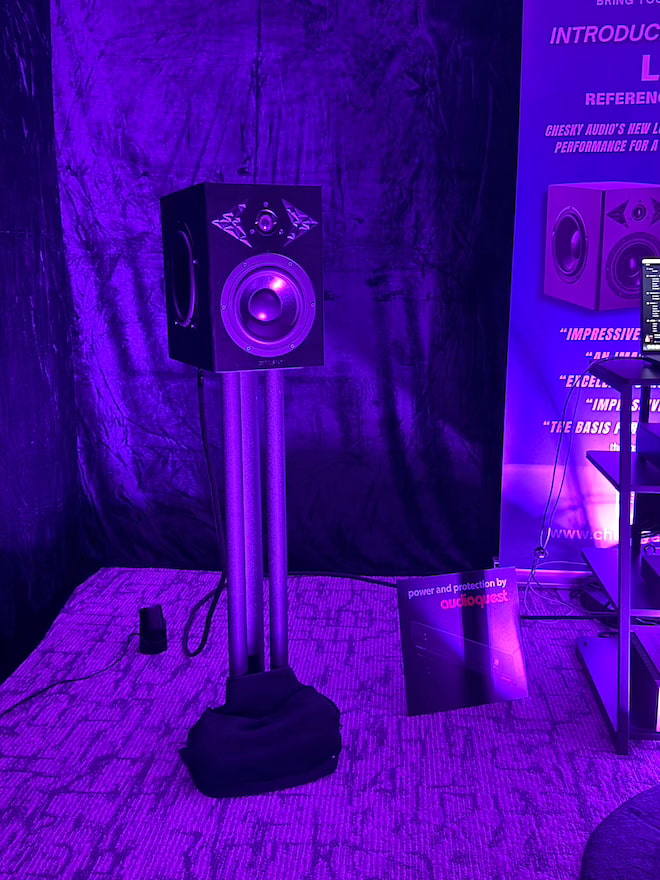
Eighteen-year-old Lucca Chesky returned to Capital Audiofest 2025 with his sophomore design, the LC2 bookshelf speaker ($2,000/pair), following last year’s acclaimed LC1 ($1,000/pair). While similar in appearance, the LC2 is a complete redesign—larger, more refined, and built with higher-quality components, including a new tweeter and crossover network. The cabinets remain 3D-printed, retaining the signature dual side-firing woofer configuration that produces bass response far deeper than you’d expect from a compact enclosure.
The LC2s were paired with Schiit Audio electronics totaling around $10,000, putting the full system well beyond most entry-level budgets. Yet in the context of a show filled with six-figure systems, the LC2 setup stood out as one of the few truly affordable—and genuinely exciting—rigs on display. The speakers delivered tight, extended bass, a balanced midrange, and crisp, natural highs that easily put them in contention as one of the best performers in the $2K category. For a designer barely old enough to vote, Luca Chesky’s trajectory looks every bit as impressive as his speakers sound.
Mission 700 & 750: Classic Sound, Modern Execution
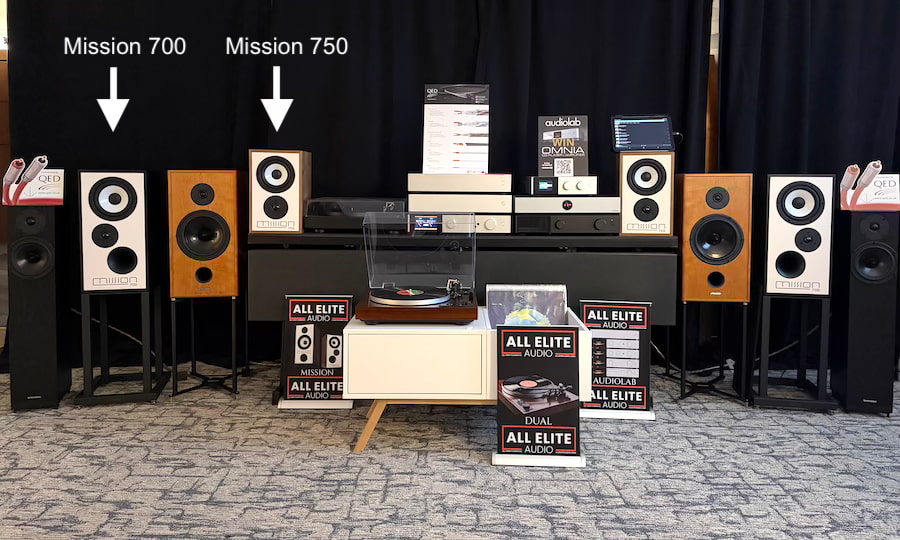
Mission showcased two of its latest bookshelf designs at CAF 2025—the larger 700 ($1,999/pair) and the compact 750 ($1,299/pair)—both driven by Audiolab electronics. The family resemblance was clear: rich tone, punchy dynamics, and that unmistakable British warmth that’s defined Mission for decades.
What surprised me most was how close the 750 came to matching the 700’s performance despite its smaller size and drivers (5.25-inch on the 750 vs. 6.5-inch on the 700). The 750 offered impressive bass extension, lively midrange energy, and a level of musical engagement that far exceeds its modest price. With our previous Editor’s Choice winner, the Q Acoustics 5020, now retailing for $1,199, this $1K–$1.5K price bracket has suddenly become one of the most competitive in hi-fi. Mission’s latest offerings prove that great sound doesn’t need to come with a luxury tax.
GoldenEar T44: A Serious Sleeper in the $5K Class

Now part of the Paradigm/MartinLogan group, GoldenEar continues to refine its formula for high-value performance, and the new T44 ($5,000/pair as shown) might be its most complete design yet. This slim tower integrates a built-in 5″x9″ oval 250-watt powered subwoofer, a 4.5-inch midrange, and GoldenEar’s signature folded ribbon tweeter, all working together to deliver full-range sound from a compact footprint.
Paired with an Anthem STR Integrated Amplifier ($5K) and HiFi Rose RS151 Streamer ($5,700) the total system ($16K) delivered far more than its price would suggest. The bass was deep and authoritative, the midrange clean and articulate, and the ribbon tweeter added a layer of air and spaciousness that elevated the entire presentation. Simply put, the T44 is one of the most impressive loudspeakers I’ve heard in the $5K range—a true sleeper that combines audiophile finesse with everyday practicality.
Perlisten S7t: Effortless Realism at a High Price

At $21,990 per pair, the Perlisten S7t isn’t exactly an impulse buy—but it has a quality that’s hard to quantify. “Inviting” might be the best word for it. There’s a natural ease to the presentation, a lifelike texture to instruments—like the unmistakable pluck of a guitar string—that pulls you in and keeps you listening.
All the hallmarks of a reference-grade loudspeaker are here: explosive dynamics, holographic imaging, and impressive depth that gives recordings a sense of real space. Yet the S7t never sounds analytical or forced—it’s precise without being sterile, detailed without losing warmth. If you’re building a serious system in this price tier, put the S7t on your short list and prepare to lose a few hours rediscovering your favorite albums.
Alcons Audio Home Theater: When Price Is No Object

For Keith Yates, designing cost-no-object private cinemas is nothing new—but this year’s collaboration with DreamScapes A/V set a new benchmark. The system featured an Alcons Audio 11.8.4 speaker system, powered and processed by Alcons’ amps and top-tier electronics — Storm Audio IS Elite 32 MK3 Processor ($30K), Christie 4K860 projector ($12,400), madVR Envy Extreme MK3 ($16K), and Kaleidescape Strato V ($4,500) movie player, firing onto a 135-inch Stewart Filmscreen Harmony G3 16:9 screen.
In addition, such theater systems go beyond just equipment installation. DreamScapes A/V built most of the acoustic treatments, while Overtone Acoustics supplied the fiberglass ones. A joint effort for room calibration combined the expertise of teams from DreamScapes A/V and Keith Yates Design, along with Matt Trinklein of Storm Audio, Jason Welsh of Kaleidescape, and Naaman Freifeld of 11Hi-Fi.
The result was nothing short of breathtaking. The presentation achieved beyond-cinema levels of realism, with thunderous dynamics and visceral impact that made “The Mission scene” from Top Gun: Maverick feel like a live-fire exercise. Every explosion, every jet pass, every whisper came through with startling precision and control. This was the kind of system that doesn’t just play movies—it redefines what home theater can be. If you don’t flinch at the price tag, this is the one to dream about.
Krix Home Theater: Small Room, Big Impact
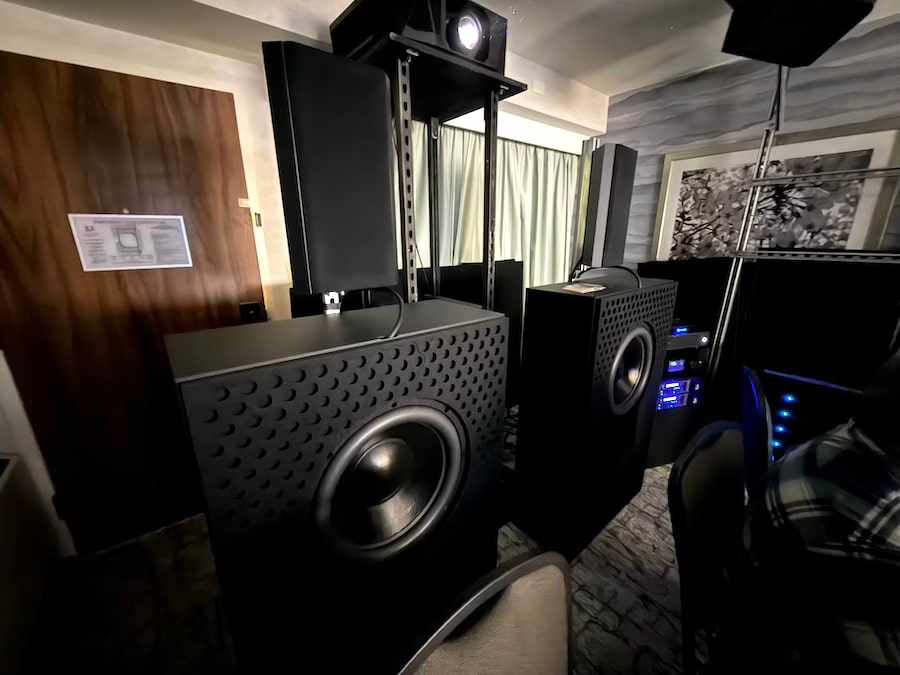
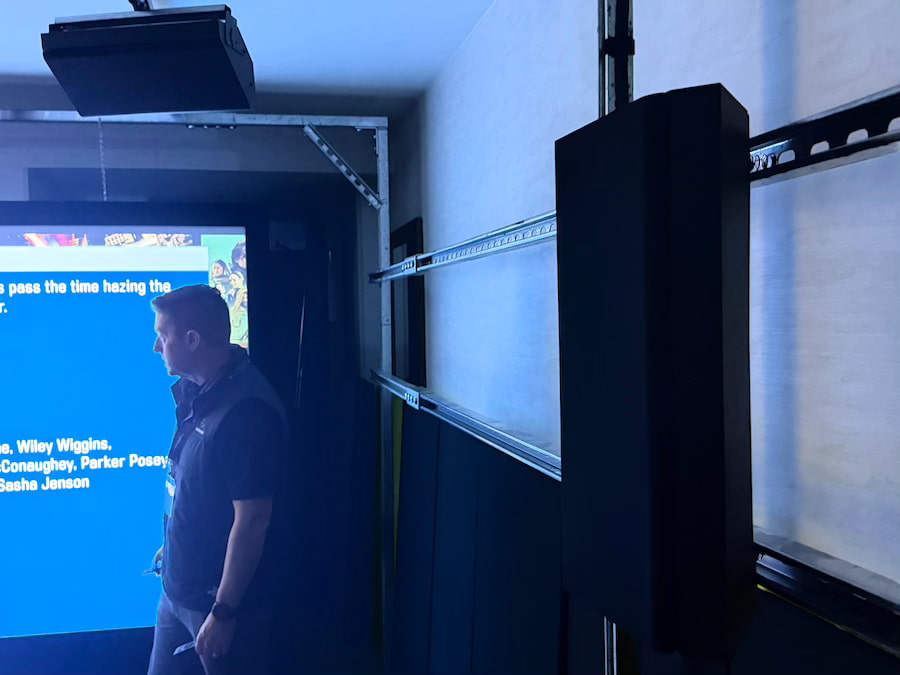
Krix nearly didn’t get their home theater demo off the ground at Capital Audiofest 2025—the assigned room turned out to be smaller than expected. But by 5 a.m. on the final day, the DreamScapes A/V team had pulled off a minor miracle, fitting a full 11.6.6-channel system (~$200K) into the space, complete with two massive 18-inch infrasonic subwoofers tucked behind the rear seats and four more behind the 120-inch Stewart Filmscreen Harmony G3 screen ($3,153).
With gear filling the walls and seating limited to six, the setup used an Epson QL7000 projector ($35K) provided by Epson with a madVR Envy Core Mk1 video processor ($6,500), Kaleidescape Strato V source ($4500), ten Benchmark AHB2 amps ($3,500 each), and a Storm Audio ISP Elite 24 MK3 surround processor ($26K). Despite the tight quarters and challenging acoustics, the system delivered serious punch and clarity. During the car chase and gunfight sequence from No Time to Die, the Krix setup managed to convey the intensity and scale of a far larger theater—tight, immersive, and controlled. Proof that with the right engineering and setup, even a small room can deliver big-cinema energy.
Paradigm / Anthem 7.2.4 Home Theater: Smart Design, Big Payoff

I wasn’t expecting to come across a nearly $70K Paradigm 7.2.4 home theater demo at Capital Audiofest 2025, but it turned out to be one of the more thoughtfully executed setups of the show. The system featured Paradigm’s flagship Founder Series 120H towers ($9K/pair) and matching 90c center channel ($3K) across the front with an 83-inch LG G5 TV. Surround speakers included smaller Founder series towers, the 80F on the sides ($3900/pair) and 100F ($5600/pair) in the rear, plus four on-ceiling mounted height speakers, the Millennia LP2 ($600 each). Meanwhile bass was handled by two subwoofers, an XR13 ($5K) and XR11 ($4K). Then it was all powered by an Anthem AVM90 surround processor ($7500) with MCA525 ($3800) and MCA225 ($2300) Gen 2 amps.
What really set this room apart was the clever installation. Instead of the usual compromise with angled or front-wall height speakers, they managed to mount true down-firing height speakers directly into the ceiling, creating a seamless and enveloping Dolby Atmos sound field. The result was immersive, balanced, and surprisingly cohesive—proof that great setup design can make just as much difference as expensive gear.
SVS / Orchard Audio 5.2.4 Home Theater: Class D for the Win
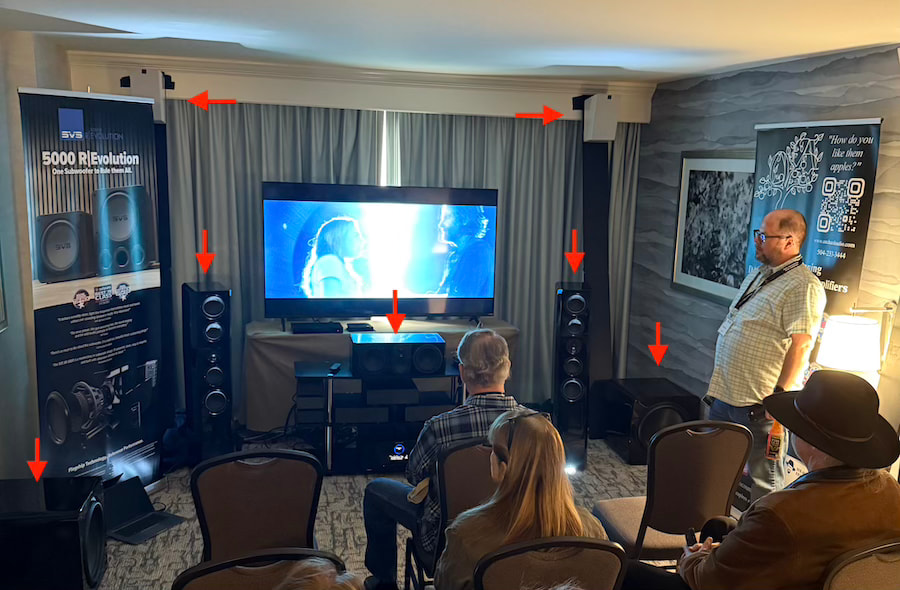
SVS stepped up in a big way this year, teaming with Orchard Audio to power each channel with Class D amplification—a noticeable upgrade from the AVR-based demos of past shows. The system featured a 5.2.4 configuration built around SVS’s newest, but smallest lineup: Ultra Evolution Towers ($3,000/pair), Center ($799), Nano Bookshelf Surrounds ($900/pair), Ultra Evolution Elevation height speakers ($449 each x 4), and two SB-5000 R|Evolution subwoofers ($1,799 each).
All told, that’s $10,100 in SVS speakers, packed into a modest hotel room, plus the Orchard amps ($15,300 in total) and Marantz AV7706 ($3,200)—bringing the total system cost to roughly $28,600 all-in without cables. The result? Tight, dynamic, and effortlessly powerful sound with precise Atmos effects and deep, controlled bass that filled the room without overwhelming it. It was easily the most affordable full Atmos system at the show, and one that proved just how far smart Class D amplification and thoughtful setup can go. Class D for the win, indeed.
STAX SR-007S Combo: Electrostatic Excellence
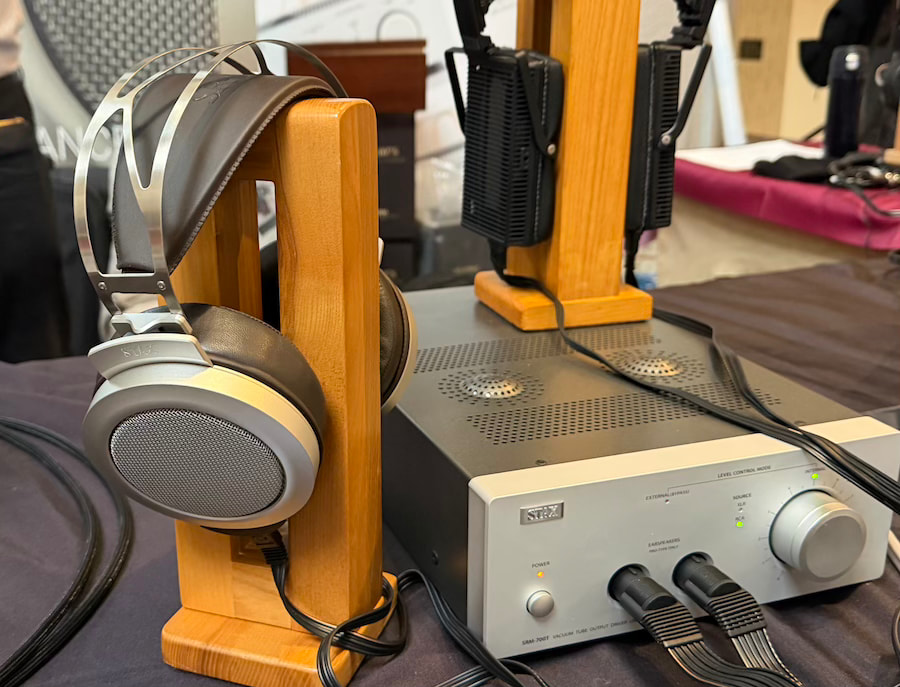
Head-fi wasn’t a major focus at Capital Audiofest 2025, but a few standout headphone setups made their presence known. Chief among them was the STAX SR-007S ($2,390) / SRM-700T ($3,400) electrostatic headphone system—a headphone and vacuum tube amplifier combo priced under $6,000.
Electrostatic headphones have long set the benchmark for detail, clarity, and speed, though not every model manages to balance that precision with musical warmth. The SR-007S did exactly that. It delivered stunning resolution without sounding clinical, with a tonal balance that felt natural and inviting. Comfort was excellent as well, making this one of those rare high-end headphones you could listen to for hours without fatigue. For those who live for detail and transparency, STAX still sits firmly on the throne.
Technics / VPE 2.1 System: Small Setup, Big Surprise
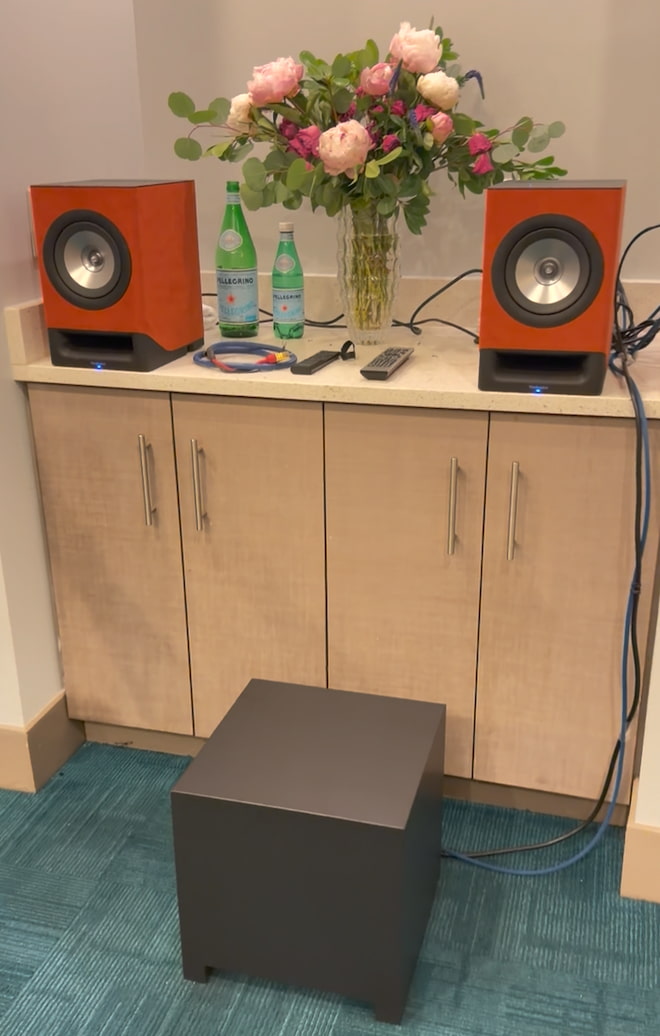
Tucked into a cubby in the massive Magnepan ballroom at the Even Hotel, I stumbled across a modest but impressive system combining Technics’ CX700 wireless speakers ($3,499) with VPE’s Model 1B subwoofer ($1,300). VPE, a young company only four years old, originally made its name designing dipole subwoofers optimized for Magnepan panels. Their subs use a supercardioid polar pattern that focuses output forward, minimizing sidewall reflections and unwanted room interaction.
In this setup, the VPE sub didn’t just complement the Magnepans nearby—it transformed the compact Technics desktop system into something far more substantial. The integration was smooth, the bass deep and articulate, and there wasn’t a trace of boominess despite the sub being awkwardly placed in front of the cabinet below. Getting a subwoofer to sound this balanced in that kind of placement is no small feat. For audiophiles who’ve long dismissed subwoofers as impractical or intrusive, VPE may have finally cracked the code.
Best Accessory: IsoAcoustics GAIA Neo
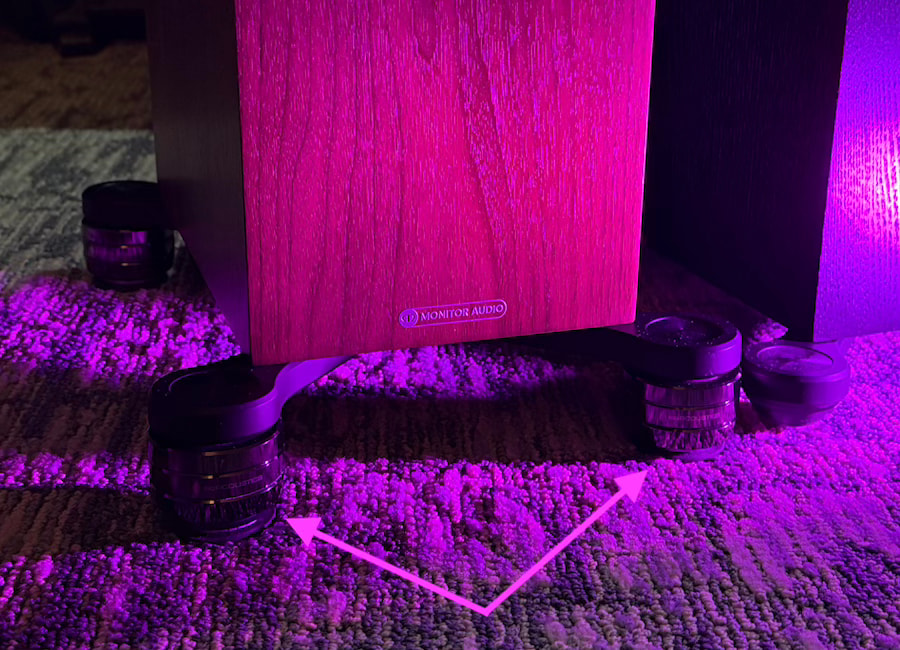
There’s no simpler or more effective upgrade for floorstanding speakers than a set of IsoAcoustics isolation feet. It’s one of those rare “plug-and-play” accessories that consistently delivers audible results. The new GAIA Neo takes that proven formula even further, offering enhanced isolation, refined height adjustment, and an updated design that integrates cleanly with virtually any speaker.
More than 50 loudspeakers now use IsoAcoustics feet either as standard or optional equipment, and it’s easy to understand why. The improvement in imaging, stereo separation, and low-frequency clarity is immediate and repeatable—almost any speaker benefits. Are they inexpensive? No. Do they work? Without question. Year after year, their demos at Capital Audiofest continue to prove that small details can make a very big difference.
The Bottom Line
Capital Audiofest 2025 once again proved why it remains a cornerstone of the North American hi-fi show circuit. Attendance was strong—especially on Saturday—with demo rooms packed but still manageable, and Sunday offering the perfect opportunity for longer, more focused listening sessions. The quality of sound on display was high across the board, with several world-class systems and a healthy mix of established brands and smaller innovators making an impression.
That said, the show still faces some challenges. The crowd skewed older, with very few younger attendees and almost no women present—a demographic reality that’s becoming impossible to ignore. The Head-Fi segment also felt underrepresented compared to Warsaw or CanJam Dallas, despite the growing importance of headphones and portable audio to new listeners.
As Editor-in-Chief Ian White has pointed out in past coverage, CAF’s biggest issue may not be sound—it’s outreach. White, a GWU graduate and former D.C./Rockville resident, notes that the show’s organizers have failed to engage the tens of thousands of students from nearby universities like GWU, Georgetown, University of Maryland, American, Howard, UVA, George Mason, and Catholic University—a large, affluent, and music-loving audience sitting right in their backyard.
The Hilton Rockville remains a convenient and well-run venue, but if CAF wants to thrive long-term, it needs to evolve beyond catering primarily to Boomers and upper Gen Xers. The show has the gear, the energy, and the legacy—it just needs the next generation to show up and listen.
Related Reading:
- Saros Audio Europa At CAF 2025: A No-Compromise Fully Differential Headphone & Preamp For The High-End Crowd
- Chesky Audio’s $498 Audiophile Bookshelf Speaker Is Kicking Ass And Taking Names At CAF 2024
- Zu Audio Is Bringing Its New Method Bookshelf Loudspeaker And SUB To CAF 2024 [Updated]
- House Of Stereo’s $600,000 Focal/T+A Stereo System Steals The Show At Capital Audiofest 2024

